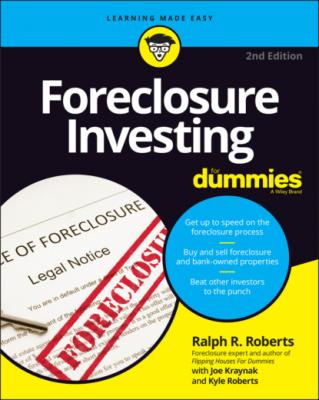Foreclosure Investing For Dummies. Ralph R. Roberts
Чтение книги онлайн.
Читать онлайн книгу Foreclosure Investing For Dummies - Ralph R. Roberts страница 18
 the foreclosure process, but they’re too upset and confused to think clearly or explore their options, and they’re so angry or fearful that they hesitate to contact the lender to work out a solution.
the foreclosure process, but they’re too upset and confused to think clearly or explore their options, and they’re so angry or fearful that they hesitate to contact the lender to work out a solution.
In the following sections, I introduce various ways that homeowners in foreclosure can stop or delay the foreclosure process. Use this information not only to better assist distressed homeowners, but also to prepare yourself for the possibility that the homeowners may choose to cut you out of a promising deal by successfully negotiating with the lender or another investor.
A SMOOTH OPERATOR
I once purchased a property at a sheriff sale and did everything I could to contact the homeowner. I even tried to drop in for a personal visit, but she slammed the door in my face as though she knew who I was and had been expecting me.
Later, I discovered that a con artist named Brian had gotten to her during the redemption period. He established some sort of emotional connection with the homeowner, took her to the county building to pick up the overbid (the money I paid for the property at auction in excess of what was owed on it), and convinced her that he could save her house for her.
Brian bought her a vacuum cleaner and a few groceries in exchange for her signature on a quitclaim deed — a document signing away her rights to the property. He videotaped her making statements that he thought would protect him legally.
With quitclaim deed in hand, Brian redeemed the property, and I got my money back. Then he sold the property to an investor named Ray. Ray came to my office. Without knowing what had transpired, I bought the property and sold it to another investor. When that investor showed up at the homeowner’s house to work out a rental agreement with her, he learned about the con job and wanted nothing to do with the property.
Eventually, the matter wound up in court. I bought the property back from the other investor and gave the homeowner some money so that she could move to a more-affordable home. While in court, I got a $100,000 judgment against Brian. Last I heard, Brian was scheduled for a creditors’ hearing.
Never take advantage of homeowners for your own benefit. After all, this property is their home, and any equity they have in that home is theirs. Commit to becoming a champion of the homeowners. If you can help them and earn some compensation for your assistance, everybody wins. Quick money never lasts. By acting with integrity and in the best interest of the homeowners, you provide a much-needed service to a suffering portion of your community.
Reinstating the mortgage
Before the foreclosure auction, homeowners who can get their hands on enough cash may have the option to reinstate the mortgage, which consists of making up for all missed payments and paying any late fees or other penalties.
To reinstate the mortgage, the homeowners must contact the lender before the auction date to verify that reinstatement is an option. If the option is available, the homeowners must work out a payment schedule with their lender.
Requesting and receiving a forbearance
When homeowners have a temporary loss of income with the promise of regaining their financial footing, the lender may agree to a forbearance, in which the homeowners can delay payment for a short period or negotiate a payment plan to make up for missed payments over the course of several months, as explained in the following section.
The lender may also offer some sort of combination between a forbearance and reinstatement, enabling homeowners to delay payment for a short period and then bring their payments current by a specific date.
Mortgage modification or repayment plan
To enable financially strapped homeowners to make up missed payments slowly, a lender may agree to a mortgage modification or repayment plan:
A mortgage modification consists of adding the past-due payments and penalties to the remaining principal, so the homeowners pay off the past-due amounts and penalties over the life of the loan. This arrangement is commonly known as adding amounts due to the back of the loan.
A repayment plan enables the homeowners to submit payment of a portion of their past-due amount and penalties with future payments until the past-due amount and penalties are paid off.
When homeowners are already having trouble making their monthly mortgage payments and don’t have the resources to cover higher payments, mortgage modification and repayment plans are rarely ideal solutions. Often, these options simply delay the inevitable.
Filing for bankruptcy
Filing for bankruptcy sounds like a permanent solution to a significant financial predicament like foreclosure, but it’s not the ideal solution. It destroys the homeowner’s credit rating for seven years or so and doesn’t exactly wipe all debt off the books. Bankruptcy simply relieves some of the debt burden and provides homeowners some extra time to restructure their remaining debt.
Bankruptcy is one more option for distressed homeowners, however, and it’s certainly something you should know about as a foreclosure investor. By filing for bankruptcy at least a couple of days before the auction date, a homeowner can delay the foreclosure process and leave a property that you’ve already purchased in limbo — at least until the foreclosure trustee and the courts sort out all the legal issues.
Agreeing to a deed in lieu of foreclosure
When